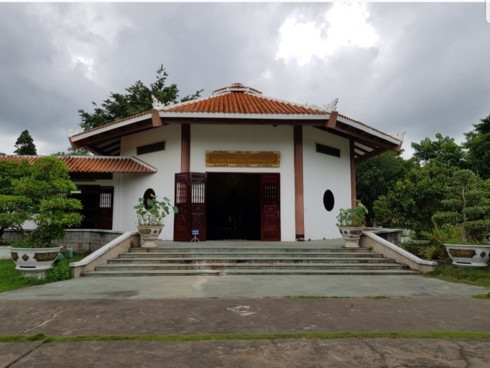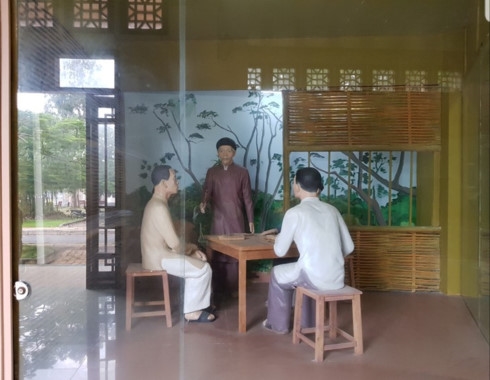Nguyen Sinh Sac was born in 1862 in Kim Lien village, Nam Dan district, Nghe An province in Central Vietnam. He became an orphan at four years of age. A smart boy with a passion for learning, Sac was adopted by a Confucian scholar and given a good education.
After earning a bachelor’s degree, Sac married Hoang Thi Loan, daughter of his adoptive father. Sac earned a Junior Doctor title and served as a mandarin during the Nguyen dynasty. In the last years of his life, Sac was a teacher and herbal doctor in Hoa An village, Cao Lanh city, where he passed away in November, 1929.
    |
 |
|
Temple inside the complex worshiping Nguyen Sinh Sac |
His small grave was upgraded after Vietnam’s reunification in 1975. His newer tomb looks to the east with a marble censer on top. Decorating the tomb complex are rare bonsais and other trees donated by pilgrims from across Vietnam. In front of the tomb is a star-shaped lotus pond with a seven-meter-high white lotus statue in the middle, which symbolizes the pure, noble life of Junior Doctor Nguyen Sinh Sac.
Tuyet Nhi, a tour guide for the Nguyen Sinh Sac relic site, said “The 9-hectare complex comprises a tomb, an exhibition house, a worshiping house, President Ho Chi Minh’s stilt house, and a corner of Hoa An village. The tomb was and inaugurated in February, 1977 and was tiled with marble transported here from Quang Ninh province. It has an arched roof resembling a lotus petal decorated with nine dragon heads, which protects the tomb and represent the Mekong River delta, whose other name, ‘Cuu Long,’ means nine dragons.”
    |
 |
|
Honor Nguyen Sinh Sac - a beloved teacher and herbal doctor during the last years of his life |
Highlights of the Nguyen Sinh Sac complex include a recreation of Hoa An village and President Ho Chi Minh’s stilt house, which exactly resembles the one in Hanoi. Locals offer homestays in Hoa An village in a traditional southern house.
Tran Van Phuoc, a visitor from Kien Giang province, said “This is my first visit to the Nguyen Sinh Sac relic site. The tomb and stele are beautiful and majestic. I really admire Sac’s contributions. I intend to come here again someday.” The museum house of Sac’s life and career will be upgraded to teach younger generations about Vietnam’s revolutionary traditions.
Phan Thi Vu Quyen, the relic site’s director, told VOV, “The relic site is a frequent a venue for pilgrim tours, inductions of new Party and Youth Union members, and ceremonies honoring those who excel in studying and following President Ho Chi Minh’s moral example. Junior Doctor Nguyen Sinh Sac was a patriotic Confucian scholar who was passionate about learning. A fund to support poor students in Dong Thap province is named after him. His tomb complex receives about 500,000 visitors each year, including many overseas Vietnamese.”
The site is crowded during the lunar new year holiday, festivals, and Sac’s death anniversary, which has evolved into a local festival held between the 25th and 27th day of the 10th lunar month. State leaders often offer incense and plant trees at the Nguyen Sinh Sac relic site.
Source: VOV